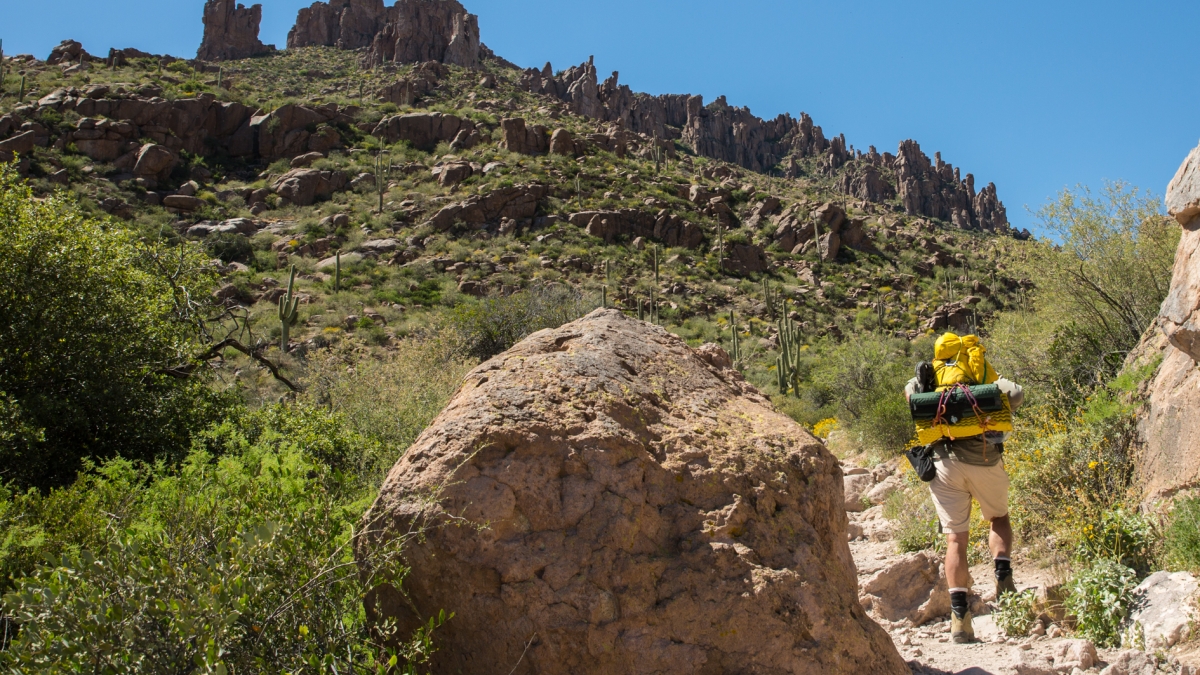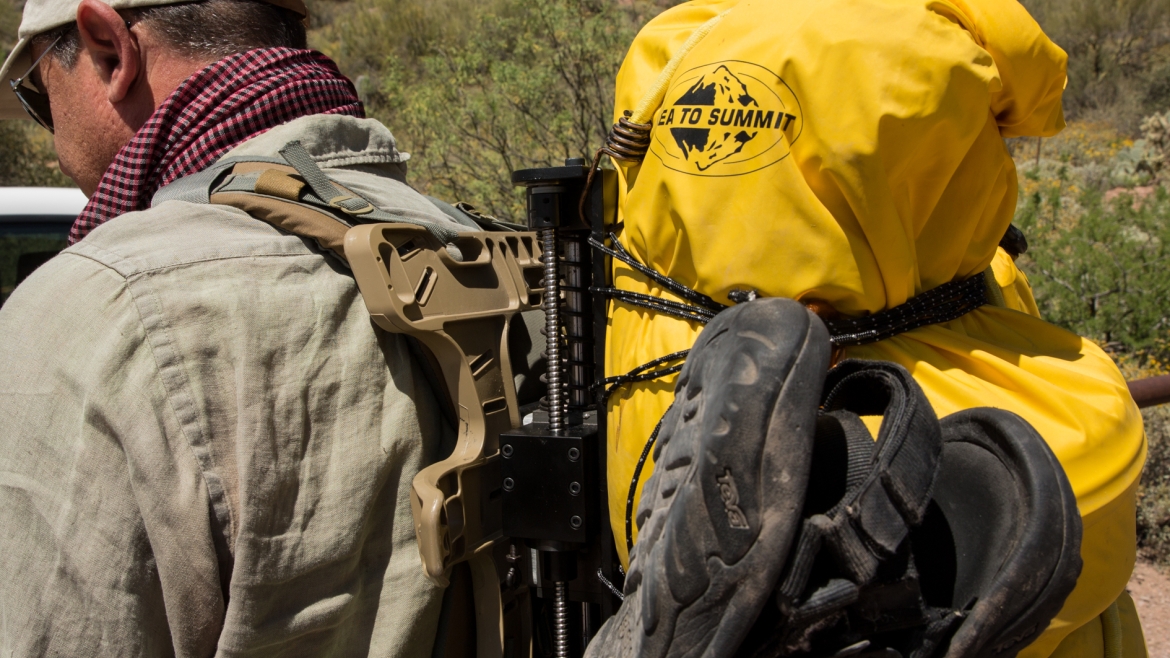Pogo pack: ASU innovator creates wearable, trail tech — and we put it to the test

There are two truths in backpacking: You will labor like a pack mule, and you will savor views most people never see.
As a backpacker, you love your gear. It keeps you comfy, healthy and happy in some god-awful conditions. Without it, you would lose your way, your lunch and your life.
At the same time, you hate that murderous, spine-crushing, thigh-melting heap of misery strapped to your back. That’s true even after you’ve honed and mastered your own system over decades. You’ve stripped down, streamlined and efficiency-maximized every ounce hanging between your shoulder blades. And it’s still miserable.
Let’s face it: The technology hasn’t really changed since somebody thousands of years ago attached straps to a bag and threw it on their back, despite what the marketing departments of outdoor retailers claim. “Revolutionary XYZ suspension system! You’ll hardly notice it’s there!”
You’ll notice it’s there. What’s there is the crux of the problem and the laws of physics: There’s 40, 50, 60, even 90 pounds on your back that’s hard to ignore, much less make go away.
• • •
Thomas Sugar at Arizona State University’s Human Machine Integration Lab works on problems like this. A mechanical engineering professor, Sugar and his team build exoskeletons — wearable robotics — that help people perform tasks or survive harsh environments. The Army came to him and asked him to come up with a way to make carrying a heavy load easier.
Read more: Sugar to host, present at robotics conference in Phoenix
He came up with an oscillating backpack. There’s a load-bearing shoulder harness attached to a back frame like every backpack has, with a hip belt and sternum strap. On the back are powerful springs driving a plate up and down, mechanical components, a circuit board, battery and wiring.
After Sugar and his team came up with the concept and design, engineering associate Eduardo Fernandez built the pack in two weekends. The shoulder harness was from a Marine Force Recon pack.
The Pogo Suit was designed to decrease the metabolic cost of carrying a heavy infantryman’s load, around 70 to 120 pounds. The suit does this by oscillating the load up and down at just the right time. Components predict when the next step will take place in milliseconds. When done correctly, the load’s impulse force is minimized.
“Imagine when you’re running with a school backpack,” Sugar said, “just a small backpack, and it’s slamming down on your shoulders at the wrong time, and it doesn’t feel good. This one goes in the opposite direction. It oscillates to make the backpack feel lighter.”
• • •
Does it work? Is the Pogo Suit the Holy Grail of the trail? We wanted to field-test the prototype in the wilderness. This had to be a real trip, carrying real supplies and gear to an objective and back, not an afternoon dry run up an urban mountain with deadweight. Plus, it’s just cool to test something unique. It’s the only pack in the world that oscillates to make the wearer feel better, and there’s only one of them.
“I’ve never seen one of those before!” an excited hiker exclaimed on the trail. “What is that thing?”
We took the Pogo Suit out to the Peralta Trail in the Superstition Mountains east of metro Phoenix. Objective: a 2-mile climb with 1,400 feet of elevation gain up to Fremont Saddle, dropping down the other side until we found water and made camp, then out the next day.
Plug in a lithium ion battery, switch it on, and a light blinks before the Pogo Suit starts to react. A perforated plate on the back about 10 inches wide by 16 inches long is the load-bearing surface. This part rises up and down as you hike.
On flat surfaces, the pack’s mechanics didn’t make that much of a difference. On steep hills, it really came into its own. When you’re doing those steep thigh-burner steps, at the moment you’d really feel the full weight of the load pulling down and back, it’s like a giant hand coming along and lifting the pack off your back for a split second.
It’s a really amazing feeling, after decades of backpacking, to have a giant hand come down and hold your pack up at a crucial second. It’s completely unexpected. It’s like suddenly being able to fly or breathe underwater or grab a hot coal.

A hiker tries out the Pogo Pack on the Peralta Trail in the Superstition Mountains.
Photos by Ken Fagan/ASU Now
One quirk is the noise. It screeches and grinds and shrieks. Does it have issues? Yes. But it’s a prototype, not a market-ready product, so it’s not fair to say it doesn’t have this, that or the other thing.
“We thought it was an angry animal,” one woman said coming around the corner to where we took a break from the 92-degree heat.
Another issue is that it doesn’t stop doing its thing after you’ve stopped for a breather. Stand and pant, and it jerks you around like a marionette.
And the Pogo Suit didn’t fare well in the lab. Sugar and his team saw a metabolic cost decrease, but only enough to justify the suit’s 12-pound weight itself. The Army lost interest, but joked they’d buy it just to beat up recruits.
“The drawback was that it did make the backpack heavier,” Sugar said. “You have the motor and frame that oscillates back and forth. It’s not a commercial prototype at this point. … We would need to make it simpler and lighter.”
With improvements, is there a possibility oscillating packs will be sold at REI 10 years from now?
“Maybe, if you could get the costs down, and the battery technology,” Sugar said. “You’d have to somehow be able to charge those batteries for a couple of days. You could carry a solar panel or some fuel and a little generator and charge batteries that way.”
• • •
Packs such as these are the future. There is a cross-pollination between the military and outdoor gear makers. Sometimes soldiers adopt commercial gear. Outdoorsmen will buy military surplus and cannibalize it. (White-water rafting came about through a huge surplus of World War II rafts.)
“I think this could be used recreationally, like let’s say you wanted to hike some of the Grand Canyon,” Sugar said. “We have talked about a rental business for exoskeletons. They cost a lot right now, but if you rent them, you could hike the Grand Canyon and back out. I think that could be a first stage. That would be neat.”
Sugar will present his work — which includes a jet pack exoskeleton enabling a wearer to run a four-minute mile, a Spider-Man suit that can climb any surface, and a cool suit that lowers ambient body temperatures 20 degrees — this month at WearRAcon, the Wearable Robotics Association Conference organized by the Wearable Robotics Association, from April 19–21 in Phoenix. The conference will cover areas including health and fitness monitoring, recreation, business and military applications.
Sugar will have some of his suits on hand and will take questions. He’s pleased with the progress of his latest gadget, and he’s already thinking up improvements.
“I’m excited to hear on your hike it was really helping you go uphill,” Sugar said. He added later, “This was the first real-world attempt that anyone made.”
Videos by Ken Fagan/ASU Now
More Science and technology

Breakthrough copper alloy achieves unprecedented high-temperature performance
A team of researchers from Arizona State University, the U.S. Army Research Laboratory, Lehigh University and Louisiana State University has developed a groundbreaking high-temperature copper alloy…

4 ASU researchers named senior members of the National Academy of Inventors
The National Academy of Inventors recently named four Arizona State University researchers as senior members to the prestigious organization.Professor Qiang Chen and associate professors Matthew…

Transforming Arizona’s highways for a smoother drive
Imagine you’re driving down a smooth stretch of road. Your tires have firm traction. There are no potholes you need to swerve to avoid. Your suspension feels responsive. You’re relaxed and focused on…

